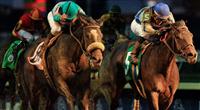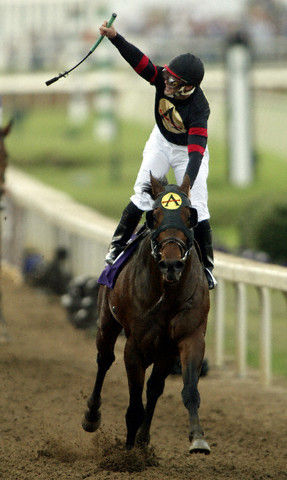Horse Breeding Pictures Biography
Source(Gogle.com.pk)This article needs additional citations for verification. Please help improve this article by adding citations to reliable sources. Unsourced material may be challenged and removed. (June 2013)
Mares and foals
Horse breeding is reproduction in horses, and particularly the human-directed process of selective breeding of animals, particularly purebred horses of a given breed. Planned matings can be used to produce specifically desired characteristics in domesticated horses. Furthermore, modern breeding management and technologies can increase the rate of conception, a healthy pregnancy, and successful foaling.
Contents [hide]
1 Terminology
2 Estrous cycle of the mare
2.1 Effects on the reproductive system during the estrous cycle
2.2 Hormones involved in the estrous cycle, during foaling, and after birth
3 Breeding and gestation
3.1 Care of the pregnant mare
4 Foaling
4.1 Foal care
5 How breeds develop
6 History of horse breeding
7 Deciding to breed a horse
8 Choosing breeding stock
9 Costs related to breeding
10 Covering the mare
10.1 Live cover
10.2 Artificial insemination
10.3 Advanced reproductive techniques
11 See also
12 References
13 Further reading
Terminology[edit]
The male parent of a horse, a stallion, is commonly known as the sire and the female parent, the mare, is called the dam. Both are genetically important, as each parent provides half of the genetic makeup of the ensuing offspring, called a foal. (Contrary to popular misuse, the word "colt" refers to a young male horse only; "filly" is a young female.) Though many horse owners may simply breed a family mare to a local stallion in order to produce a companion animal, most professional breeders use selective breeding to produce individuals of a given phenotype, or breed. Alternatively, a breeder could, using individuals of differing phenotypes, create a new breed with specific characteristics.
A horse is "bred" where it is foaled (born). Thus a foal conceived in England but foaled in the United States is regarded as being bred in the US.[1][2] In some cases, most notably in the Thoroughbred breeding industry, American- and Canadian-bred horses may also be described by the state or province in which they are foaled. Some breeds denote the country, or state, where conception took place as the origin of the foal.[citation needed]
Similarly, the "breeder", is the person who owned or leased the mare at the time of foaling. That individual may not have had anything to do with the mating of the mare.[1][3] It's important to review each breed registry's rules to determine which applies to any specific foal.
In the horse breeding industry, the term "half-brother" or "half-sister" only describes horses which have the same dam, but different sires.[4] Horses with the same sire but different dams are simply said to be "by the same sire", and no sibling relationship is implied.[5] "Full" (or "own") siblings have both the same dam and the same sire. The terms paternal half-sibling, and maternal half-sibling are also often used. Three-quarter siblings are horses out of the same dam, and are by sires that are either half-brothers (i.e. same dam) or who are by the same sire.[6]
Thoroughbreds and Arabians are also classified through the "distaff" or direct female line, known as their "family" or "tail female" line, tracing back to their taproot foundation bloodstock or the beginning of their respective stud books. The female line of descent always appears at the bottom of a tabulated pedigree and is therefore often known as the bottom line.[6]
"Linebreeding" technically is the duplication of fourth generation or more distant ancestors.[5] However, the term is often used more loosely, describing horses with duplication of ancestors closer than the fourth generation. It also is sometimes used as a euphemism for the practice of inbreeding, a practice that is generally frowned upon by horse breeders, though used by some in an attempt to fix certain traits.
Estrous cycle of the mare[edit]
See also: Equine reproductive system
Stallion checking a mare in estrus. The mare welcomes the stallion by lowering her rear and lifting her tail.
The estrous cycle (also spelled oestrous) controls when a mare is sexually receptive toward a stallion, and helps to physically prepare the mare for conception. It generally occurs during the spring and summer months, although some mares may be sexually receptive into the late fall, and is controlled by the photoperiod (length of the day), the cycle first triggered when the days begin to lengthen. The estrous cycle lasts about 19–22 days, with the average being 21 days. As the days shorten, the mare returns to a period when she is not sexually receptive, known as anestrus. Anestrus - occurring in the majority of, but not all, mares - prevents the mare from conceiving in the winter months, as that would result in her foaling during the harshest part of the year, a time when it would be most difficult for the foal to survive.
This cycle contains 2 phases:
Estrus, or Follicular, phase: 5–7 days in length, when the mare is sexually receptive to a stallion. Estrogen is secreted by the follicle. Ovulation occurs in the final 24–48 hours of estrus.
Diestrus, or Luteal, phase: 14–15 days in length, the mare is not sexually receptive to the stallion. The corpus luteum secretes progesterone.
Depending on breed, on average, 16% of mares have double ovulations, allowing them to twin, this does not affect the length of time of estrus or diestrus.
Effects on the reproductive system during the estrous cycle[edit]
Changes in hormone levels can have great effects on the physical characteristics of the reproductive organs of the mare, thereby preparing, or preventing, her from conceiving.
Uterus: increased levels of estrogen during estrus cause edema within the uterus, making it feel heavier, and the uterus loses its tone. This edema decreases following ovulation, and the muscular tone increases. High levels of progesterone do not cause edema within the uterus. The uterus becomes flaccid during anestrus.
Cervix: the cervix starts to relax right before estrus occurs, with maximal relaxation around the time of ovulation. The secretions of the cervix increase. High progesterone levels (during diestrus) cause the cervix to close and become toned.
Vagina: the portion of the vagina near the cervix becomes engorged with blood right before estrus. The vagina becomes relaxed and secretions increase.
Vulva: relaxes right before estrus begins. Becomes dry, and closes more tightly, during diestrus.
Hormones involved in the estrous cycle, during foaling, and after birth[edit]
The cycle is controlled by several hormones which regulate the estrous cycle, the mare's behavior, and the reproductive system of the mare. The cycle begins when the increased day length causes the pineal gland to reduce the levels of melatonin, thereby allowing the hypothalamus to secrete GnRH.
GnRH (Gonadotropin releasing hormone): secreted by the hypothalamus, causes the pituitary to release two gonadotrophins: LH and FSH.
LH (Luteinizing hormone): levels are highest 2 days following ovulation, then slowly decrease over 4–5 days, dipping to their lowest levels 5–16 days after ovulation. Stimulates maturation of the follicle, which then in turn secretes estrogen. Unlike most mammals, the mare does not have an increase of LH right before ovulation.
FSH (Follicle-stimulating hormone): secreted by the pituitary, causes the ovarian follicle to develop. Levels of FSH rise slightly at the end of estrus, but have their highest peak about 10 days before the next ovulation. FSH is inhibited by inhibin (see below), at the same time LH and estrogen levels rise, which prevents immature follicles from continuing their growth. Mares may however have multiple FSH waves during a single estrous cycle, and diestrus follicles resulting from a diestrus FSH wave are not uncommon, particularly in the height of the natural breeding season.
Estrogen: secreted by the developing follicle, it causes the pituitary gland to secrete more LH (therefore, these 2 hormones are in a positive feedback loop). Additionally, it causes behavioral changes in the mare, making her more receptive toward the stallion, and causes physical changes in the cervix, uterus, and vagina to prepare the mare for conception (see above). Estrogen peaks 1–2 days before ovulation, and decreases within 2 days following ovulation.
Inhibin: secreted by the developed follicle right before ovulation, "turns off" FSH, which is no longer needed now that the follicle is larger.
Progesterone: prevents conception and decreases sexual receptibility of the mare to the stallion. Progesterone is therefore lowest during the estrus phase, and increases during diestrus. It decreases 12–15 days after ovulation, when the corpus luteum begins to decrease in size.
Prostaglandin: secreted by the endrometrium 13–15 days following ovulation, causes luteolysis and prevents the corpus luteum from secreting progesterone
eCG - equine chorionic gonadotropin - (also called PMSG (pregnant mare serum gonadotropin): chorionic gonadotropins secreted if the mare conceives. First secreted by the endometrial cups around the 36th day of gestation, peaking around day 60, and decreasing after about 120 days of gestation. Also help to stimulate the growth of the fetal gonads.
Horse Breeding Pictures for Kids Black and White to Color Funny Hd Wallpapepr Images Pics
Horse Breeding Pictures for Kids Black and White to Color Funny Hd Wallpapepr Images Pics
Horse Breeding Pictures for Kids Black and White to Color Funny Hd Wallpapepr Images Pics
Horse Breeding Pictures for Kids Black and White to Color Funny Hd Wallpapepr Images Pics
Horse Breeding Pictures for Kids Black and White to Color Funny Hd Wallpapepr Images Pics

Horse Breeding Pictures for Kids Black and White to Color Funny Hd Wallpapepr Images Pics
Horse Breeding Pictures for Kids Black and White to Color Funny Hd Wallpapepr Images Pics
Horse Breeding Pictures for Kids Black and White to Color Funny Hd Wallpapepr Images Pics

Horse Breeding Pictures for Kids Black and White to Color Funny Hd Wallpapepr Images Pics

Horse Breeding Pictures for Kids Black and White to Color Funny Hd Wallpapepr Images Pics
Horse Breeding Pictures for Kids Black and White to Color Funny Hd Wallpapepr Images Pics
Horse Breeding Pictures for Kids Black and White to Color Funny Hd Wallpapepr Images Pics
Horse Breeding Pictures for Kids Black and White to Color Funny Hd Wallpapepr Images Pics

Horse Breeding Pictures for Kids Black and White to Color Funny Hd Wallpapepr Images Pics

Horse Breeding Pictures for Kids Black and White to Color Funny Hd Wallpapepr Images Pics
Horse Breeding Pictures for Kids Black and White to Color Funny Hd Wallpapepr Images Pics

No comments:
Post a Comment